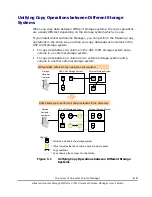
2-8
About Universal Volume Manager Operations
Hitachi Universal Storage Platform V/VM Universal Volume Manager User’s Guide
Configuring Universal Volume Manager
Before configuring the Universal Volume Manager settings, you need to answer
the following:
•
Which ports can be connected to external storage systems
•
Which external storage system and volumes should be mapped as the
internal volumes
•
How to configure external volume groups
•
What external volume attributes to be configured
•
How to configure cross-subsystem paths
•
How to make volume usable from the local storage system
Choosing External Port
The port used for Universal Volume Manager must be set as the external port.
When the external storage system is connected to the external port of the
local storage system, you can view the information on the external storage
system from the Storage Navigator computer. The external storage system
cannot be connected to the ports other than the external port.
In order to set the port attribute to external, the LU paths set to the port must
be released. The attribute of the port where the LU paths are already set
cannot be changed to external. Therefore, you must identify ports whose
attributes can be changed to external before starting the Universal Volume
Manager operations.
Note:
The ports whose attributes are set for remote copy software (e.g., RCU
target, initiator) or other features cannot be used as external ports for
Universal Volume Manager. In addition, change the port attribute to external if
the port attribute is set to other than external.
Choosing and Mapping External Volumes
When you connect an external storage system to an external port, volumes in
the external storage system (external volumes) become available for mapping
as volumes in the local storage system (internal volumes). Identify the
volumes in each external storage system that should be mapped as internal
volumes.
•
You cannot access the data that is stored in an external volume beyond the
maximum available capacity.
















































